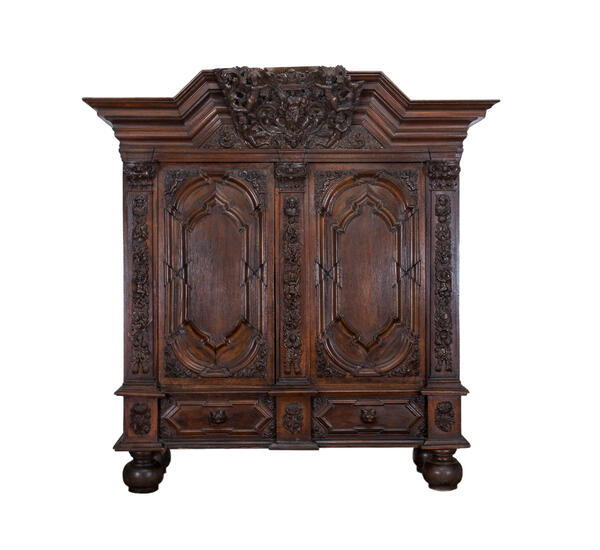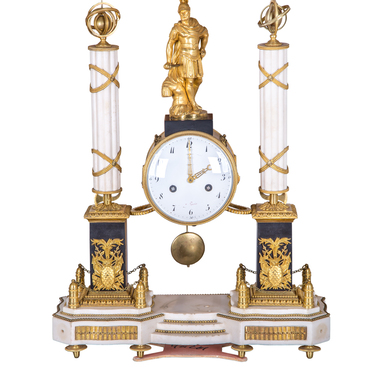The cabinet entered the museum from the estate of Counts Uvarov “Red Mountain” in the village of Karacharovo, near Murom. The last owners of the estate, Alexey Sergeevich Uvarov (1825-1884) and Praskovya Sergeevna Uvarova (1840-1924) are famous Russian scientists, archaeologists, great connoisseurs and collectors of antiquities. Their ancestors, the Sheremetevs and the Razumovsky began to collect the art furniture. Many exemplars of furniture of the XVIII-XIX centuries were acquired during the travels of the Uvarov spouses in Europe. The collector’s cabinet decorated the living room of the manor house in Karacharovo, along with other pieces of furniture of Baroque and Renaissance periods, ancient paintings by European artists and no less picturesque wall-printed carpets.
The carved oak cabinet is an example of household furniture of the early XVIII century, made by German furniture makers in the “Baroque” style, a lush and pretentious style that has been widespread throughout Europe since the XVI century. It originated in Southern Europe, penetrated into England, Holland, France, and in the last third of the XVII century came to Germany. Here it was called the “imperial style” and found its manifestation in architecture, sculpture, painting, as well as in music, theater and poetry. The furniture in the “Baroque” style is replete with numerous architectural details, complex carved forms. The cabinet impresses with its monumentality and grandeur. Its functional significance is the storage of various items, clothes, and books.
The cabinet is a type of “Danzig” cabinet. Oak, walnut veneered monumental cabinets with strongly protruding cornice and columns were made in the north of Germany in the cities of Danzig and Hamburg in the late XVII — early XVIII centuries. The cabinet, like many of its brethren, is very large, almost two and a half meters high, it stands on five spherical flattened legs (“turnips”). The cabinet has two massive doors with curly panels, three pilasters with overhead carvings between them, two deep drawers with handles in the form of a lion’s head at the bottom. The top has a cornice with carved overhead figures of the goddess Demeter and four angels, two of whom hold a crown. Inside the cabinet there are three shelves on which ancient monuments of applied art from the Uvarov collection were once stored.
The carved oak cabinet is an example of household furniture of the early XVIII century, made by German furniture makers in the “Baroque” style, a lush and pretentious style that has been widespread throughout Europe since the XVI century. It originated in Southern Europe, penetrated into England, Holland, France, and in the last third of the XVII century came to Germany. Here it was called the “imperial style” and found its manifestation in architecture, sculpture, painting, as well as in music, theater and poetry. The furniture in the “Baroque” style is replete with numerous architectural details, complex carved forms. The cabinet impresses with its monumentality and grandeur. Its functional significance is the storage of various items, clothes, and books.
The cabinet is a type of “Danzig” cabinet. Oak, walnut veneered monumental cabinets with strongly protruding cornice and columns were made in the north of Germany in the cities of Danzig and Hamburg in the late XVII — early XVIII centuries. The cabinet, like many of its brethren, is very large, almost two and a half meters high, it stands on five spherical flattened legs (“turnips”). The cabinet has two massive doors with curly panels, three pilasters with overhead carvings between them, two deep drawers with handles in the form of a lion’s head at the bottom. The top has a cornice with carved overhead figures of the goddess Demeter and four angels, two of whom hold a crown. Inside the cabinet there are three shelves on which ancient monuments of applied art from the Uvarov collection were once stored.



